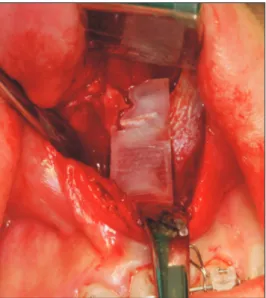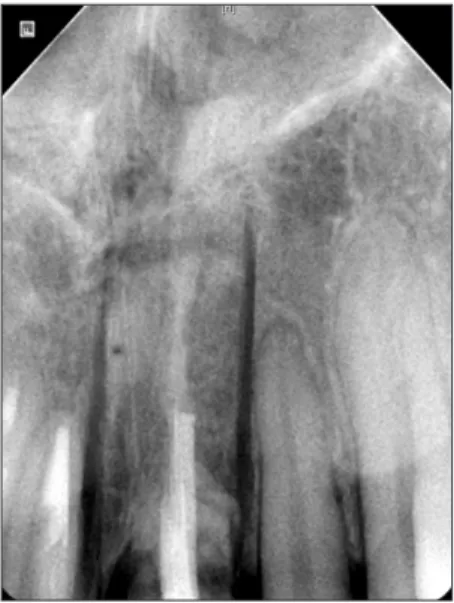127 was affected by bony ankylosis and could not be displaced, even with orthodontic therapy. Thus, we decided to distract it by cutting the left central incisor area and the neighboring bones to induce osteogenesis.
The osteotomy plan was based on a surgical simulation.
First, we constructed a three-dimensional (3D) image of the maxillary region, based on a computed tomography (CT) im- age.(Fig. 1) Then, we performed a simulated dento-osseous segmental osteotomy with three cuts: one between the left and right maxillary central incisors, a second between the left maxillary central incisor and the lateral incisor, and a third cut in the apical region of the left maxillary central incisor.
Then, with the CT data of the maxillary bony surface and the cutting data from the surgical simulation, we used Mimics software (version 14.0; Materialise, Leuven, Belgium) to de- sign a surgical guide to fit the maxillary region. The surgical guide was then manufactured from biocompatible materials (VisiJet Crystal; 3D Systems Inc., Rock Hill, SC, USA) with a 3D printer (ProJet 3500 HDMax 3D Printer; 3D Systems Inc.).
In surgery, a vestibular incision was used to expose the maxillary central incisor bony region. Then, the manufac- tured surgical guide was placed in the appropriate position.
(Fig. 2) After confirming that the guide had been appropri- ately fitted, the bone was cut with a piezo saw, following the side of the guide. The cutting depth was determined by the lengths of the sections measured during the simulation.
(lower left image in Fig. 1) Then, the apical region of the
I. Introduction
Trauma-induced bony ankylosis that occurs during a growth period can hamper the vertical growth of alveolar bones. This condition results in an open bite that poses aes- thetic and functional problems
1,2. A single-tooth dento-osse- ous osteotomy may be the optimal treatment plan for bony ankylosis
2,3. Here, we introduce a method for performing single-tooth dento-osseous osteotomy with a surgical guide created with computer-aided design/computer-aided manu- facturing (CAD/CAM) technologies. This guide design was based on preoperative surgical simulation data.
II. Technical Note
A 19-year-old female patient visited the hospital for treat- ment of an open bite in the anterior maxilla. She had a history of reduction, caused by trauma-induced avulsion of the left maxillary central incisor. The left maxillary central incisor
TECHNICAL NOTE
Ji-Yeon Lee
Department of Orthodontics, National Health Insurance Service Ilsan Hospital, 100 Ilsan-ro, Ilsandong-gu, Goyang 10444, Korea
TEL: +82-31-900-0629 FAX: +82-303-3448-7138 E-mail: ilsanortho@gmail.com
ORCID: http://orcid.org/0000-0002-4738-1184
This is an open-access article distributed under the terms of the Creative Commons Attribution Non-Commercial License (http://creativecommons.org/licenses/by-nc/4.0/), which permits unrestricted non-commercial use, distribution, and reproduction in any medium, provided the original work is properly cited.
CC
Single-tooth dento-osseous osteotomy with a computer-aided design/
computer-aided manufacturing surgical guide
Sang-Hoon Kang
1, Moon-Key Kim
1, Ji-Yeon Lee
2Departments of
1Oral and Maxillofacial Surgery and
2Orthodontics, National Health Insurance Service Ilsan Hospital, Goyang, Korea
Abstract (J Korean Assoc Oral Maxillofac Surg 2016;42:127-130)
This clinical note introduces a method to assist surgeons in performing single-tooth dento-osseous osteotomy. For use in this method, a surgical guide was manufactured using computer-aided design/computer-aided manufacturing technology and was based on preoperative surgical simulation data.
This method was highly conducive to successful single-tooth dento-osseous segmental osteotomy.
Key words: Tooth ankylosis, Surgical guide
[paper submitted 2015. 11. 12 / revised 2015. 12. 30 / accepted 2016. 1. 1]
Copyright Ⓒ 2016 The Korean Association of Oral and Maxillofacial Surgeons. All rights reserved.
http://dx.doi.org/10.5125/jkaoms.2016.42.2.127
pISSN 2234-7550·eISSN 2234-5930
J Korean Assoc Oral Maxillofac Surg 2016;42:127-130
128
maxillary central incisor was cut with the piezo saw, using a groove in the surgical guide. Similarly, the cutting depth was determined with reference to the distance between the surgi- cal guide and the bone on the maxillary palatal side. Next, the dento-osseous segment that was separated from the maxilla, and blood circulation was confirmed.
Starting six days after the single-tooth dento-osseous seg- mental osteotomy, the left maxillary central incisor bone seg- ment was distracted by approximately 0.5 mm per day toward the occlusal plane with an orthodontic device. The distraction was performed considering the upper displacement and the axis of the tooth. Seven days after the distraction, we fixed the position with orthodontic brackets. At the eight-week follow-up, there were no signs of gingival recession, and we observed appropriate wound healing with adequate mobility.
This study was approved by the Institutional Review Board of the National Health Insurance Service Hospital (2015-11- 007).
III. Discussion
Single-tooth dento-osseous segmental osteotomy is a good
Fig. 1. Surgical simulation and surgical guide for dento-osseous segmental osteotomy of the left maxillary central incisor region (lower right). This three-dimensional reconstructed image of the inside of the mouth shows the proper placement of the surgical guide (purple) and the planned cutting lines (red). Measurement of the cutting depth from the surgical guide surface to the palatal side is shown in the lower left panel.
Sang-Hoon Kang et al: Single-tooth dento-osseous osteotomy with a computer-aided design/computer-aided manufacturing surgical guide. J Korean Assoc Oral Maxillofac Surg 2016
Fig. 2. Photograph of the placement of the surgical guide for dento-osseous segmental osteotomy of the left anterior maxillary region.
Sang-Hoon Kang et al: Single-tooth dento-osseous osteotomy with a computer-aided design/computer-aided manufacturing surgical guide. J Korean Assoc Oral Maxillofac Surg 2016
Single-tooth dento-osseous osteotomy with a CAD/CAM surgical guide
129 edge to the maxillary palatal side, which can be measured in the simulation.
Currently, preoperative surgical simulations confer an array of advantages
6,7. The benefits of more accurate and shorter operations when using CAD/CAM-derived surgical guides are clear. The position and form of the osteotomy line can be adjusted in simulated surgery, minimizing the possibility of dental damage. Moreover, using a cutting guide allows the surgeon to adjust the depth when cutting, leading to a less- invasive and stable osteotomy. The usefulness of surgical guides may also depend on the surgeon’s expertise and the type of surgery.
There are several drawbacks to use of a cutting guide.
There is a cost associated with the effort, time, and equip- ment needed to design and manufacture these devices. Even when a surgical guide cannot be designed or used, taking ad- vantage of preoperative simulation surgery to derive relevant measurements can still reduce surgical error during the actual operation. In addition, the costs associated with the design and use of cutting guides will decrease as the associated tech- nologies improve.
Surgical guides can be of most use in complex osteotomy, when it might be difficult to accurately reproduce the re- sults of a surgical simulation in the actual operation room;
in these scenarios, a surgical guide can be highly beneficial.
We believe that this report will be followed by more thor- ough research on various designs of surgical guides for use in dento-osseous osteotomy. We expect that further research on the development and assessment of dento-alveolar surgical devices, together with iterative improvements in computing power and software, will expand the possibilities for com- puter-assisted surgeries. Enhanced navigation and precision robotic surgeries will further increase the power of the now well-established computer-aided treatment field in dento- alveolar surgery.
This report showed that preoperative simulation and the manufacture of a simple surgical guide based on simulation data greatly facilitated successful single-tooth dento-osseous segmental osteotomy.
Conflict of Interest
No potential conflict of interest relevant to this article was reported.
option when vertical alveolar bone growth is hampered by bony ankylosis
2-4. Distraction of a dento-osseous segment can be performed with an orthodontic device that is either fixed with screws inserted into the osseous segment or with a bracket that is bonded onto the coronal part of the tooth
2-4. However, it may be difficult to determine the cutting section between adjacent teeth, and the procedure may hinder blood circulation to the dento-osseous fragment. In addition, com- plications such as gingival recession can occur
2,5.
The small size and simple design of the surgical guide described in this study can facilitate the single tooth dento- osseous osteotomy by shortening the duration of surgery and reducing the risk of trauma. Despite its advantages, however, it can damage the surrounding teeth if positioned inappro- priately during the operation.(Fig. 3) The surgical guide design must consider the thickness of the cutting saw. In the present case, the bone cuts were placed slightly wider (to the left and right of the right maxillary central incisor) than preoperatively planned; this placement was partly due to the surgical guide design, which required the cutting saw to lean against the side edge of the guide. A better design would be to increase the size of the guide, which would enhance its positional stability, and to employ grooves for all cuts. Under these conditions, the saw could be placed within the grooves during the osteotomy. Postoperative trauma on the maxillary palatal side flaps might also be reduced by calculating the cutting depth based on the distance from the guide’s superior
Fig. 3. Postoperative apical radiograph of the left maxillary central incisor region.
Sang-Hoon Kang et al: Single-tooth dento-osseous osteotomy with a computer-aided design/computer-aided manufacturing surgical guide. J Korean Assoc Oral Maxillofac Surg 2016
J Korean Assoc Oral Maxillofac Surg 2016;42:127-130
130
3. Ohkubo K, Susami T, Mori Y, Nagahama K, Takahashi N, Saijo H, 84.
et al. Treatment of ankylosed maxillary central incisors by single- tooth dento-osseous osteotomy and alveolar bone distraction. Oral Surg Oral Med Oral Pathol Oral Radiol Endod 2011;111:561-7.
4. Im JJ, Kye MK, Hwang KG, Park CJ. Miniscrew-anchored alveo- lar distraction for the treatment of the ankylosed maxillary central incisor. Dent Traumatol 2010;26:285-8.
5. Liem AM, Hoogeveen EJ, Jansma J, Ren Y. Surgically facilitated experimental movement of teeth: systematic review. Br J Oral Maxillofac Surg 2015;53:491-506.
6. Kang SH, Lee JW, Kim MK. Use of the surface-based registration function of computer-aided design/computer-aided manufacturing software in medical simulation software for three-dimensional sim- ulation of orthognathic surgery. J Korean Assoc Oral Maxillofac Surg 2013;39:197-9.
7. Lee JW, Kim MK, Kang SH. Unilateral intraoral vertical ramus osteotomy based on preoperative three-dimensional simulation surgery in a patient with facial asymmetry. J Korean Assoc Oral Maxillofac Surg 2014;40:32-6.
ORCID
Sang-Hoon Kang, http://orcid.org/0000-0003-3335-3040 Moon-Key Kim, http://orcid.org/0000-0002-3634-3705 Ji-Yeon Lee, http://orcid.org/0000-0002-4738-1184
References
1. Rodrigues DB, Wolford LM, Figueiredo LM, Adams GQ. Manage- ment of ankylosed maxillary canine with single-tooth osteotomy in conjunction with orthognathic surgery. J Oral Maxillofac Surg 2014;72:2419.e1-6.
2. Senışık NE, Koçer G, Kaya BÜ. Ankylosed maxillary incisor with severe root resorption treated with a single-tooth dento-osseous osteotomy, vertical alveolar distraction osteogenesis, and mini-im- plant anchorage. Am J Orthod Dentofacial Orthop 2014;146:371-

